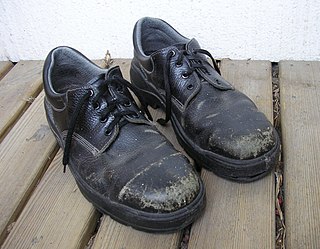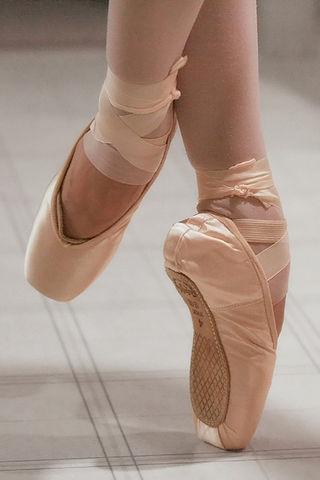
In a boot or shoe, the shank is a long, thin piece of material between the insole and outsole intended to support the foot and provide structure.

In a boot or shoe, the shank is a long, thin piece of material between the insole and outsole intended to support the foot and provide structure.
Materials and design for shanks vary widely with the purpose of the footwear. The shank of a pointe shoe used for ballet is made of flexible materials like leather, plastic, or cardstock, and may have customized length, thickness, and stiffness. Heavy boots such as those used for construction or hiking have far more rigid and durable shanks, often using steel, though contemporary shanks are more commonly made of less heat-conductive materials such as fiberglass and Kevlar. These materials' rigid nature adds a protective element, helping shield feet from puncture wounds and stone bruises. [1] The shank is crucial to the functionality of mountaineering boots, as they diminish the load incurred by the feet and calves over the course of an ascent.

A shoe is an item of footwear intended to protect and comfort the human foot. Though the human foot can adapt to varied terrains and climate conditions, it is vulnerable, and shoes provide protection. Form was originally tied to function but over time shoes also became fashion items. Some shoes are worn as safety equipment, such as steel-toe boots, which are required footwear at industrial worksites.

Footwear refers to garments worn on the feet, which typically serve the purpose of protection against adversities of the environment such as wear from rough ground; stability on slippery ground; and temperature.

A boot is a type of footwear. Most boots mainly cover the foot and the ankle, while some also cover some part of the lower calf. Some boots extend up the leg, sometimes as far as the knee or even the hip. Most boots have a heel that is clearly distinguishable from the rest of the sole, even if the two are made of one piece. Traditionally made of leather or rubber, modern boots are made from a variety of materials.

The Wellington boot, also known as the gumboot, is a type of waterproof boot.

A steel-toe boot is a durable boot or shoe that has a protective reinforcement in the toe which protects the foot from falling objects or compression. Safety shoes are effective in keeping the feet of industrial workers safe from sharp and heavy objects while working in factories.

Clogs are a type of footwear made in part or completely from wood. Used in many parts of the world, their forms can vary by culture, but often remained unchanged for centuries within a culture.

A pointe shoe, also called a ballet shoe, is a type of shoe worn by ballet dancers when performing pointe work. Pointe shoes were conceived in response to the desire for dancers to appear weightless and sylph-like and have evolved to enable dancers to dance en pointe for extended periods of time. They are manufactured in a variety of colors, most commonly in shades of light pink.
Jungle boots are a type of combat boot designed for use in jungle warfare or in hot, wet, and humid environments where a standard leather combat boot would be uncomfortable or unsuitable to wear. Jungle boots have vent holes in the instep and sometimes a canvas upper to aid in ventilation and drainage of moisture.

Hiking (walking) boots are footwear specifically designed for protecting the feet and ankles during outdoor walking activities such as hiking. They are one of the most important items of hiking gear, since their quality and durability can determine a hiker's ability to walk long distances without injury. Hiking boots are constructed to provide comfort for walking considerable distance over rough terrain. Boots that protect the hiker's feet and heel are recommended. Hiking boots give ankle support and are fairly stiff. A less popular alternative is to use light trainers with thin soles. Footwear should be neither too loose nor too tight, to help prevent blisters and sore feet. Hiking socks that wick sweat from the feet, provide warmth, and cushion the feet are recommended and a thin, inner sock may also help. Most hiking boots are also designed for other outdoor activities such as backpacking, climbing, mountaineering, and hunting.

An Australian work boot is a style of work shoe, typically constructed with a leather upper bound together with elastic sides and pull tabs on the front and back of the boot. The shoe lacks a tongue, and laces, and often contains a steel toe cap for occupational health and safety reasons. When the shoe contains a steel cap they are often known as "safety boots" or "steel toe boots". The boots generally lack an inner lining. The sole is generally polyurethane and the leather uppers are treated to be resistant to hot water, fats and mild alkaline and acid solutions.

A hazmat suit is a piece of personal protective equipment that consists of an impermeable whole-body garment worn as protection against hazardous materials. Such suits are often combined with self-contained breathing apparatus (SCBA) to ensure a supply of breathable air. Hazmat suits are used by firefighters, emergency medical technicians, paramedics, researchers, personnel responding to toxic spills, specialists cleaning up contaminated facilities, and workers in toxic environments.

Red Wing Shoes is an American footwear company based in Red Wing, Minnesota that was founded by Charles H. Beckman in 1905.

Spats, a shortening of spatterdashes, or spatter guards are a type of classic footwear accessory for outdoor wear, covering the instep and the ankle. Spats are distinct from gaiters, which are garments worn over the lower trouser leg as well as the shoe.

Engineer boots, also known as engineer's boots or engineering boots, are an American type of traditional leather work-boots. Their lace-less, rugged construction made them popular among motorcycle riders. Originally developed in the 1930s for firemen working on steam locomotives, the boots gained substantial popularity in the post–World War II era during a growing motorcycling culture. They became popular symbols of teenage rebellion in the 1950s and a common component of greaser wear. They were later adopted by skinheads and punks in the 1970s. By the 2010s, engineer boots were being popularly worn for fashion purposes, especially by non-traditional customers such as women, young urban professionals, and hipsters.
The ballet boot is a contemporary style of fetish footwear that merges the look of the pointe shoe with a high heel. The idea is to restrict the wearer's feet almost en pointe, like those of a ballerina, with the aid of long, slender heels. When upright, the feet are held nearly vertical by the shoe, thus putting nearly all of the body's weight on the tips of the toes. However, a properly tight fit will hold the shoe to the wearer's instep and heel, thereby reducing the weight on the wearer's toes.

Keen is an American footwear and accessories company based in Portland, Oregon. It was founded in 2003 by Martin Keen and Rory Fuerst. The company's products are sold in retail locations throughout the domestic American market and also are distributed worldwide.
Mountaineering, expedition or high altitude boots are a type of footwear used in mountain climbing. They are designed specifically for moving over harsh terrain.

Bunker gear is the personal protective equipment (PPE) used by firefighters. The term is derived from the fact that the trousers and boots are traditionally kept by the firefighter's bunk at the fire station to be readily available for use.

Jika-tabi are a style of footwear with a divided toe, originating in Japan. They are similar to tabi socks in both appearance and construction. Though they can be worn with traditional thonged footwear such as geta and zōri, jika-tabi are mostly designed and made to be worn alone as outdoor footwear, resembling boots that reach roughly to the mid-calf. Jika-tabi are also known as 'tabi boots'.

Xena Workwear is a Milwaukee-based women's workwear company specialized in stylish women's steel toe shoes and apparel. The company creates fashionable personal protective equipment (PPE) for women.